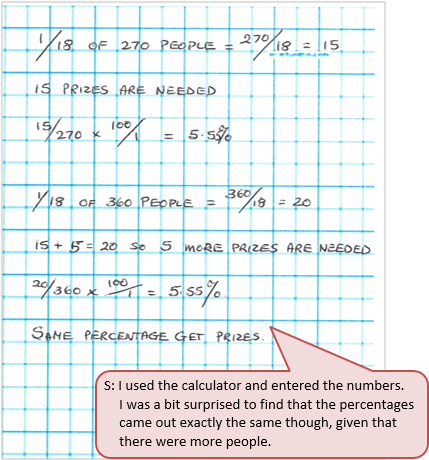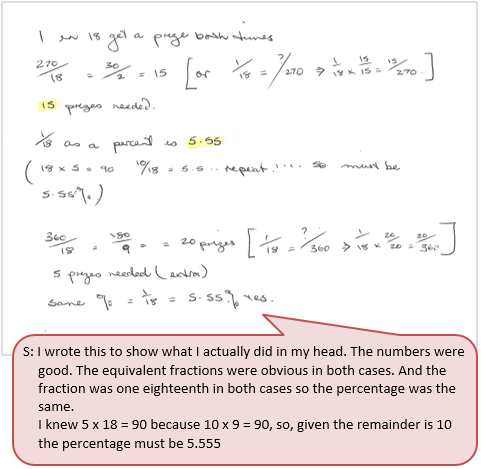The purpose of this activity is to engage students in using proportional thinking to solve a problem.
This activity assumes the students have experience in the following areas:
- Finding equivalent fractions.
- Converting between fractions, decimals, and percentages.
- Solving problems with proportions, especially rates and ratios.
The problem is sufficiently open ended to allow the students freedom of choice in their approach. It may be scaffolded with guidance that leads to a solution, and/or the students might be given the opportunity to solve the problem independently.
The example responses at the end of the resource give an indication of the kind of response to expect from students who approach the problem in particular ways.

They think abut 270 people will attend.
If they give a spot prize to every 18th person, how many prizes will they need?
What percentage of the people would get a prize?
On the day, 360 people attend. How many more spot prizes are needed?
Is the percentage of people who get the prizes the same in both cases?
The following prompts illustrate how this activity can be structured around the phases of the Mathematics Investigation Cycle.
Make sense
Introduce the problem. Allow students time to read it and discuss in pairs or small groups.
- Do I understand all the words, or should I ask for help? (Students need to recognise a percentage as a special equivalent fraction.)
- What part of the problem could I get started with?
- What do I need to find out?
- What will an answer to this problem look like? (Students should identify that the number of extra prizes needed is an important part of the answer.)
Plan approach
Discuss ideas about how to solve the problem. Emphasise that, in the planning phase, you want students to say how they would solve the problem, not to actually solve it.
- What are the maths skills I need to work this out?
- What could the solution be? What is a sensible estimate?
- How could I work out this problem using numbers, and calculations?
- What strategies can I use to get started?
- What tools (digital or physical) could help my investigation?
Take action
Allow students time to work through their strategy and find a solution to the problem.
- Does my answer seem correct? Is it close to my estimation?
- How could I make sure that I haven’t missed anything?
- Do my results look the same or different to others? Why could this be?
- Does my solution make sense? Does it match my estimation?
- Is there another possible way to solve it more efficiently?
Convince yourself and others
Allow students time to check their answers and then either have them pair share with other groups or ask for volunteers to share their solution with the class.
- Have I showed and explained how I worked out your solution.
- Can others see how I worked it out?
- How does my solution answer the question?
- How do I know if I have worked this out correctly? How can I convince other people?
- What have I noticed that seems to work all the time?
- Would that approach work for all problems like this?
Examples of work
Work sample 1
The student calculates the different amounts to find a solution.
Click on the image to enlarge it. Click again to close.
Work sample 2
The student solves the problem in a reasoned way and uses calculation to justify their approach.

